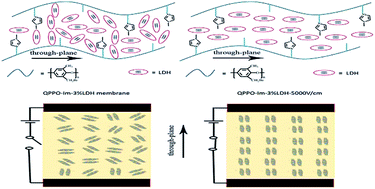Electrorheological effect induced quaternized poly(2,6-dimethyl phenylene oxide)-layered double hydroxide composite membranes for anion exchange membrane fuel cells
Abstract
To improve the performance of anion exchange membranes (AEMs), we fabricated quaternized poly(2,6-dimethyl phenylene oxide)-layered double hydroxide composite membranes by combining the advantages of the two components. Also, the electrorheological effect was employed during the casting process to induce the formation of ion conducting channels along the through-plane direction. The membrane with 3% layered double hydroxide (LDH) (QPPO-Im-3% LDH) showed the largest increase in ionic conductivity over that of the pure membrane (QPPO-Im) (15.85 mS cm−1 at 30 °C to 22.52 mS cm−1 at 80 °C vs. 5.93 mS cm−1 at 30 °C to 11.63 mS cm−1 at 80 °C). The ionic conductivity was further improved by applying the electric field treatment, confirming that the addition of LDH and the electric field greatly affect the ionic conductivity of the AEMs. Moreover, the morphology, thermal and mechanical properties, ion-exchange capacity (IEC), water uptake (WU) and swelling ratio (SR) were also studied systematically to determine the effects of LDH and electric field on the membranes.


 Please wait while we load your content...
Please wait while we load your content...